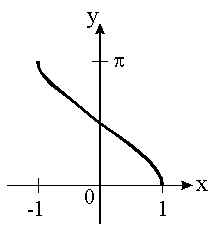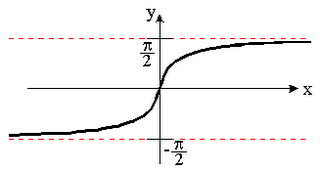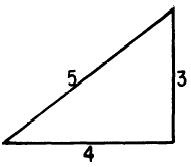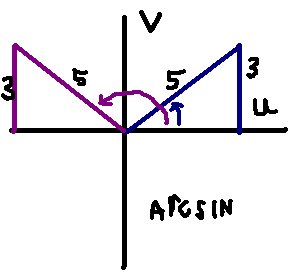Ok, so today we worked on being able to change a certain phrase into another way of expressing it. For example:
If we were given the phrase cos12x + cos10x, we could change it into 2cos11xcosx. This is how we would do it:
cos12x + cos10x =cos(11x + x) + cos(11x - x)= (for this step, you need to find two numbers that will add up to be the larger number in the original phrase and the difference will make the smaller number in the original phrase. You can find these numbers easily by using A-B/2 and A+B/2.) but now onto the next step!
cos11xcosx- sin11xsinx + cos11xcosx + sin11xsinx (the sines cancel out and you are left with
2cos11xcosxIn class we were given several formulas so we can transfer these phrases into other equal phrases. Here they are:
2cosAcosB = cos(A+B) + cos(A-B)
-2sinAsinB = cos(A+B) - cos(A-B)
2sinAcosB = sin(A+B) + sin(A-B)
2cosAsinB = sin(A+B) - sin(A-B)
sinx + siny = 2sin.5(x+y)cos.5(x-y)
sinx - siny = 2cos.5(x+y)sin.5(x-y)
cosx + cosy = 2cos.5(x+y)cos.5(x-y)
cosx - cosy = -2sin.5(x+y)sin.5(x-y)
Here is an example problem!
Given 2sin41cos24, transform this phrase into a sum.
2sin41cos24 --> 2sinAcosB = sin(A+B) + sin(A-B)
sin(41+24) + sin(41-24) = sin65 + sin17If you are given a problem like
sin2x + sin10x which takes you to the answer
2sin6xcos(-4x), you can make the (-4x) positive! If you remember that the cosine is an even function (meaning f(x) = f(-x)), then really -4x is the same as 4x. So you can just switch out the -4x for the 4x.
If you find yourself in the same problem with a sine function with the negative, remember that sine is an odd function meaning that sin(x) = -sin(x). So:
2sin13cos48 = sin61 + sin(-35) you can just change the sin61 + sin(-35) to
sin61-sin35.If you need more help on this section, check out this site:
http://www.keymath.com/x7111.xmlGo to section 5.5 and click on the other links. The links are a little fancy looking, but they have the information on there.
Ok, I think Nick is next... Alright this is what we'll do. We'll keep going with the order like it is (nick, etc.) and when we come to Tara, she won't have to do it! THANKS TARA!
Here is my personal touch!
Once upon a time, there were three princes who wished to marry a princess. The princess wished to marry one of them, but not the other two. Her father however, was rather conservative, and did not feel she was ready to marry any of them. The King decided to put all three of them to tests that he believed none of them would be able to pass. First, he blindfolded them all, then led each in turn to his individual test.
The King led Prince #1 to the base of a mountain where there were ten painted, wooden doors, glistening in the sun. "All but one of these doors in front of you are white," said the King. "If you can tell me within the next ten minutes, which door is black, then you may marry my daughter. You may not speak to anyone, and you may not remove your blindfold."
The King led Prince #2 to a hillside, and pointed out across his lush green valleys to the edge of his kingdom, where ten beautiful buildings stood. "All but one of these buildings in front of you are white," the King said. "If you can tell me within the next ten minutes, which building is black, then you may marry my daughter. You may not speak to anyone, and you may not remove your blindfold."
The King led Prince #3 to a magnificent dining table where ten places were impeccably laid out. "All but one of the napkins on this table are white," said the King. "If you can tell me within the next ten minutes, which napkin is black, then you may marry my daughter. You may not speak to anyone, and you may not remove your blindfold."
Ten minutes later, only one of the princes - the one the princess wished to marry - had succeeded at his individual test. Which one of the princes had succeeded?
Want the Answer? Here it is:
Prince #1 succeeded at his test.
How did the prince solve the test? He felt each of the doors in turn. As it was a sunny day, the black one was much hotter to the touch than the white ones, which absorbed less heat.
YAY FOR SECTION 5-5!!!


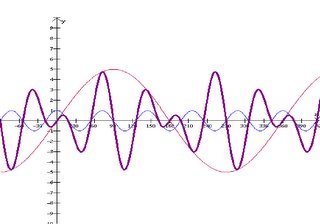
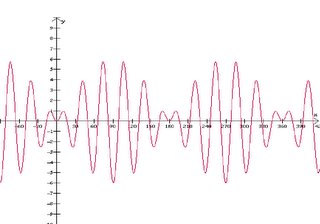

 The Graph of Arccos:
The Graph of Arccos: The Graph of Arctan:
The Graph of Arctan:
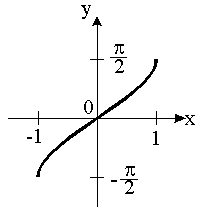 Keep in mind that the domain of the original sine function becomes the range of its inverse. Domain: [-1, 1]; Range: [o, π]; In reference to the (u,v) coordinate system: Quadrants I and II
Keep in mind that the domain of the original sine function becomes the range of its inverse. Domain: [-1, 1]; Range: [o, π]; In reference to the (u,v) coordinate system: Quadrants I and II